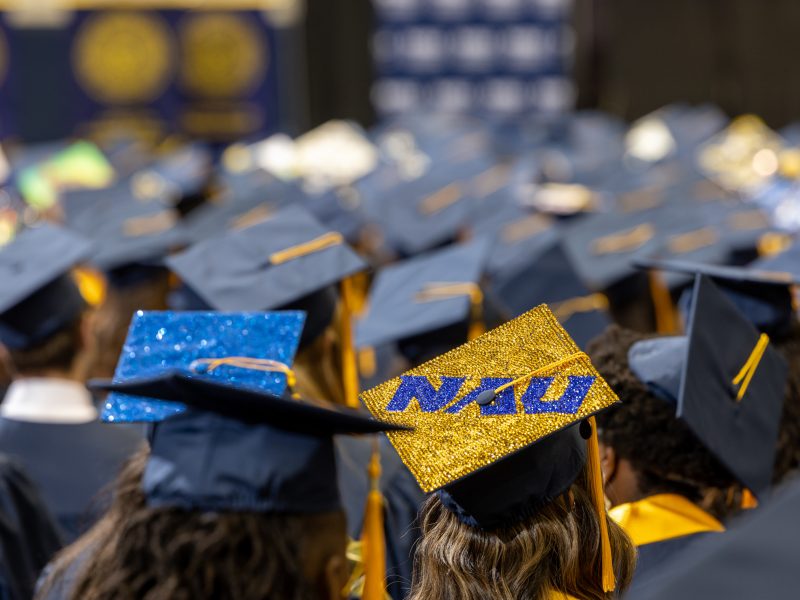The year of academic momentum
Dear Lumberjacks,
In my Fall 2023 University Convocation address, I declared this year to be the year of academic momentum. I did soto sharpen our institutional focus on student retention and completion at a time when we are juggling many critical priorities.
Today, I want to paint a clearer picture of the magnitude of the challenge; stress the imperative and potential for impact of this call to action; provide overarching goals to work toward; and set the stage for how we will organize and pace our work ahead, informed by the excellent work already underway.
The strategic context: NAU today
NAU is moving forward, expanding outward, trending upward. Fueled by our collective action, NAU is strong, with high morale, solid financial health, and major accomplishments and initiatives that align with the clear and compelling vision we articulated in NAU 2025 – Elevating Excellence. I shared highlights of our institutional trajectory in my recent State of the University address to the Arizona Board of Regents.
With back-to-back years of record numbers of incoming students, we have set a strong foundation for realizing our vision. We truly are an engine of opportunity, having expanded access and broadened participation for students from all walks of life. And with our recent elevation to Tier 1 of the Third Way Mobility Index ranking, we have demonstrated the value of an NAU degree.
But our vision goes far beyond opening our doors to more students and stewarding the quality of our academic programs. It also calls on us to serve as a vehicle of economic mobility and driver of social impact.
To meet this call, we must propel more of our students to earn their degrees (with minimal to no debt and in a timely fashion) so they are well-positioned to lead careers of consequence and live lives of purpose.
To do so, we must not only meet students where they are but also create the conditions—through innovative pedagogical practices, enhanced educational experiences, and strengthened support services—they need to meet their full potential.
It is in this context that I revisit my charge from University Convocation and call for an all-hands-on-deck approach to accelerate the work of delivering value for the talented students who—when faced with the question of to whom they would trust their educational futures—choose us, choose NAU.
The magnitude of the challenge
As I shared at Convocation, to realize our vision we need to sharpen our focus. One way we do this is by having a clear understanding of what success looks like and appreciation of the magnitude of the challenge we seek to meet. The Realizing Attainment through Increasing Strategic Enrollment (RAISE) Plan formulates a grand challenge to guide our efforts: we need to create the conditions for 100,000 people to earn high-value NAU credentials by 2035.
Now, to achieve this long-term goal, we must focus our work today to both broaden access and improve retention and graduation rates. We are doing well on the access front but have room to improve on the completion front.
Consider how we compare to our sister institutions in terms of our most recent first-year retention and six-year graduation rates for first-time, full-time students:
- First-year retention rate: At 76%, NAU’s retention rate is 10 percentage points lower than ASU’s 86% and 8 percentage points lower than UA’s 84% rate.
- Six-year graduation rate: At 59%, NAU’s six-year graduation rate is 7% percentage points lower than ASU’s 66% and 5.3% percentage points lower than UA’s 64.3%.
Clearly, from the above, the opportunity for improvement in retention and graduation rates exists. This is also true when we compare ourselves with similarly situated peer institutions from across the country.
The call to action
At convocation, I illustrated the importance of academic momentum as it relates to retention by sharing that NAU students who earn 30 units in their freshman year are 30 percentage points more likely to return as sophomores. But the reality is that academic momentum while useful as a leading indicator to monitor progress is less so as an outcome metric to which we can hold ourselves publicly accountable
Based on the benchmarks presented above, we see that to really move the needle and deliver on our promise of equitable postsecondary value, we must increase both student momentum overall—not only freshmen, but also sophomores, juniors, and seniors who are earning credits at a rate that will power timely graduation—and our first-year retention rates as a precursor to further fueling the persistence to completion and higher graduation rates that our academic momentum efforts will yield.
To help us organize and pace our short-term efforts, I present the following retention and completion goals, expanded from what was first shared at convocation to account for further reflection on our strategic context and a renewed sense of urgency to deliver on our vision:
- First-year retention rate: Increase our first-year, full-time retention rate to 80% over the next three years and to 86% within the next six years. This will bring NAU into alignment with peer institutions in the short term and our sister institutions in the longer term.
- Six-year graduation rate: Increase our six-year graduation rate to 67% over the next six years. This will bring NAU into alignment with our sister institutions, place us in the top tier of our peer institutions, and deliver on our vision as a vehicle of economic mobility and driver of social impact.
I know these are very aggressive stretch goals. In fact, our highest retention and graduation rates on record are 77.6% and 59.1%, respectively. But I also know this community is more than capable of achieving these outcomes—understanding that doing so will put us on the right trajectory to supportingmore than 100,000 people in their quest to earning high-value NAU degrees and credentials by 2035.
Of course, students have a lot of responsibility for their own success and must put forth the work and effort that is required to meet our rigorous expectations. It is ultimately up to us, however—our university’s faculty and staff—to create the conditions that will encourage students to persist in pursing their academic goals and realizing their full potential.
Potential for impact
The individual and collective benefits of realizing these goals are tremendous. For instance, by achieving our shorter-term goal of 80% retention, we will propel more than 600 additional students per year to graduation, equipped with the life-changing value of an NAU education.
In addition, increases to retention rates and degrees awarded will do much to strengthen NAU’s finances. With an increase in retention rates to 80%, we are projected to increase enrollment-related revenue by $5 million per year, providing us the means to increase our investments in the people and programs that elevate our value proposition.
Exemplary efforts across the university
Our university’s focus on academic momentum, first-year retention, and overall graduation is sharp, and I encourage all of us to reflect on our individual roles in this universitywide effort and talk to colleagues about how we can best work together to propel our students forward.
As I said earlier, the number of focused efforts across our university to improve academic momentum and increase first-year retention—and thus, degrees awarded—have intensified. In the interest of keeping this message digestible and focused, I have compiled several weeks’ worth of notes and reflections, organized around four key examples and two personal stories, in a special edition of “Notes from the President” published in The NAU Review today. I encourage you to read these to further contextualize the universitywide initiatives underway.
The road ahead
As a closing thought, I want to share one way, which was compellingly articulated at a recent all-faculty meeting I attended, in which all of us—no matter our role or department—can be a part of this work. That is, whether you are at the forefront in developing a new program or initiative or simply smiling while giving a student directions on the pedway, I encourage you to do your part in fostering an authentic, universitywide culture of “relentless welcome”—a commitment to meeting every student with care, humility, empathy, and a prioritization of their success at NAU and beyond.
Thank you for all you do. I am confident that thanks to the coherence and quality of our actions, we will ensure that if a student can and wants to build enough momentum to graduate in a timely manner with a high-value credential from NAU, there will be no institutional obstacle standing in their way and plenty of supports to help them succeed.
In partnership,

José Luis Cruz Rivera
President
